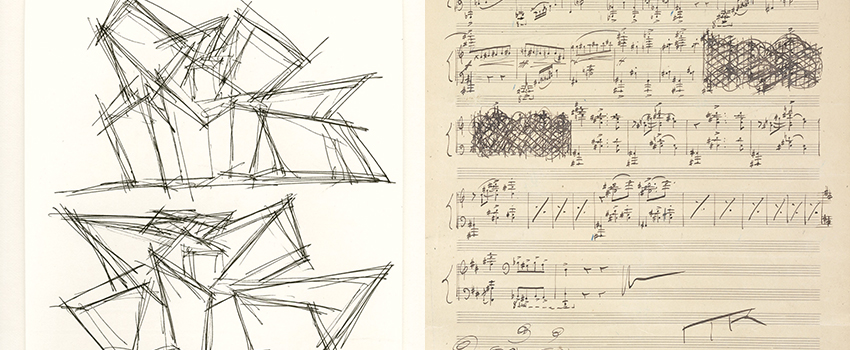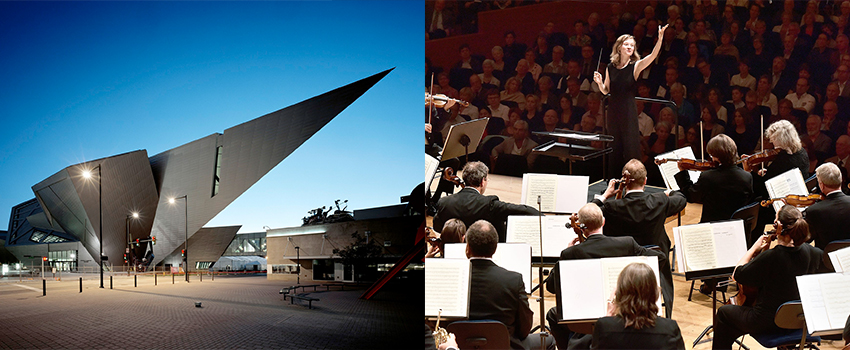Difference between revisions of "project07:Frontpage"
| Line 23: | Line 23: | ||
<br> | <br> | ||
| − | Music and architecture have shared an unique yet divided connection over hundreds of years. Both forms of art, designed to make us <i>feel</i>, and share an experience with our company. Over hundreds of years they have mutated, changed according to values of society, technical innovation and other new creative talents. As music is built on the stones of <i>melody, harmony and rythm</i>, is architecture built on the elements of <i>volume, rythm and texture</i>. Their existence is always dependent on a the composer, performer and audience. Young talent through the ages, ranging from architects, composers, performers, and thinkers have provided us with the material to make life worthwhile - not only through necessity, but also through pure enjoyment. | + | Music and architecture have shared an unique yet divided connection over hundreds of years. Both forms of art, designed to make us <i>feel</i>, and share an experience with our company. Over hundreds of years they have mutated, changed according to values of society, technical innovation and other new creative talents. As music is built on the stones of <i>melody, harmony and rythm</i>, is architecture built on the elements of <i>volume, rythm and texture</i>. Even in their deepest foundations are they both based on mathematics. Where music is structured by tension and relief, is architecture in a similar way defined by proportions. Their existence is always dependent on a the composer, performer and audience. Young talent through the ages, ranging from architects, composers, performers, and thinkers have provided us with the material to make life worthwhile - not only through necessity, but also through pure enjoyment. |
<br><br> | <br><br> | ||
Yet, they live in vastly different worlds. As much as they have in common are they different - as if they are two lifelong friends, who have in fact not yet met each other. The linearity of music cannot be compared to the holistic experience architecture will provide. Even if we ignore the obvious difference between our visual and auditory sensory system, our inmost experience through architecture is different from that of music. As even though both music and architecture are similar in the sense that they share unique structures, music is mostly an emotive and melancholic experience, while architecture is (mostly) spatial and sequential. | Yet, they live in vastly different worlds. As much as they have in common are they different - as if they are two lifelong friends, who have in fact not yet met each other. The linearity of music cannot be compared to the holistic experience architecture will provide. Even if we ignore the obvious difference between our visual and auditory sensory system, our inmost experience through architecture is different from that of music. As even though both music and architecture are similar in the sense that they share unique structures, music is mostly an emotive and melancholic experience, while architecture is (mostly) spatial and sequential. | ||
Revision as of 21:47, 30 October 2018
Roel Westrik
The Harmony of Architecture and Music
"I call architecture frozen music" - J.W. von Goethe
Music and architecture have shared an unique yet divided connection over hundreds of years. Both forms of art, designed to make us feel, and share an experience with our company. Over hundreds of years they have mutated, changed according to values of society, technical innovation and other new creative talents. As music is built on the stones of melody, harmony and rythm, is architecture built on the elements of volume, rythm and texture. Even in their deepest foundations are they both based on mathematics. Where music is structured by tension and relief, is architecture in a similar way defined by proportions. Their existence is always dependent on a the composer, performer and audience. Young talent through the ages, ranging from architects, composers, performers, and thinkers have provided us with the material to make life worthwhile - not only through necessity, but also through pure enjoyment.
Yet, they live in vastly different worlds. As much as they have in common are they different - as if they are two lifelong friends, who have in fact not yet met each other. The linearity of music cannot be compared to the holistic experience architecture will provide. Even if we ignore the obvious difference between our visual and auditory sensory system, our inmost experience through architecture is different from that of music. As even though both music and architecture are similar in the sense that they share unique structures, music is mostly an emotive and melancholic experience, while architecture is (mostly) spatial and sequential.
Graduation Project
The goal of the graduation project is not to create a definitive algorithm, which will unify both forms of art in an absolute manner. The goal is to merely show their shared qualities, and to design something that will provide an audience with an experience they will recognize as both architecture and music - without the necessity of having them both present at the same time and place.
To accomplish this, I have chosen to design an auditorium (whose function we will redefine later in the process), based upon the piece "La Valse", written by 20th century composer Maurice Ravel, a piece of music that is most dear to my heart. In later chapters we will explore all structures, characteristics and intricacies of this marvelous work.

